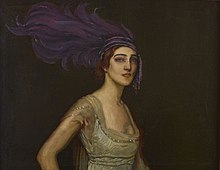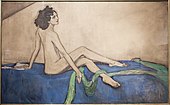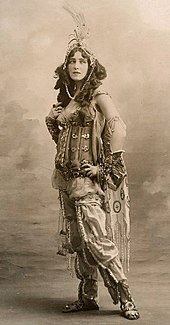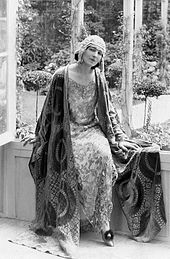Ida Rubinstein
| Cyrillic ( Russian ) | |
|---|---|
| Ида Львовна Рубинштейн | |
| Transl. : | Ida L'vovna Rubinštejn |
| Transcr. : | Ida Lwowna Rubinstein |

Ida Lwowna Rubinstein (born October 5, 1885 in Charkow , Russian Empire (now part of Ukraine ), † September 20, 1960 in Vence , France ) was a Russian dancer , actress and choreographer .
She was one of the most colorful artistic personalities of the first 40 years of the 20th century. With her expressive presentation, exotic equipment and movement theater, Rubinstein is considered the ancestor of performance . She danced freely, exuberantly and almost naked on stage, long before Josephine Baker . Stravinsky claimed she was the stupidest woman in the art world he had ever met, others described her as "fascinating beauty" and "dream woman of the 1920s".
Life

Rubinstein was born into a wealthy Jewish family. Since her parents died of typhus two years after Ida's birth , she grew up with her aunt in St. Petersburg. There she received private lessons and regularly attended the theater. Rubinstein later mastered five spoken and written languages and five others colloquially.
At first it seemed impossible in their social circles to turn theater into a profession, which was shown by the horror of the family over their lessons with artists of the Mariinsky Theater . But already at the age of 19 she played and staged Antigone after Sophocles for invited guests. Here she was already working with Léon Bakst to furnish it . However, it did not make its real debut until 1909 with a solo performance of Oscar Wilde's Salomé . At that time she was already receiving private dance lessons from Michel Fokine .
Rubinstein has now been the first performer without completed dance training in the dance company Ballets Russes of Diaghilev added. In 1909 she danced the title role in Cleopatra and later in Scheherazade at the Théâtre du Châtelet in Paris . At the Ballets Russes she always appeared in costumes by Léon Bakst. She created new fashion trends.
Rubinstein built on an oriental style, knew how to please contortions and looked extremely erotic. There was also talk of “perfectly shaped figures and jumps”. Nevertheless, she had the reputation of a "dilettante who unshakably believed herself to be a unique dancer and actress and who wanted to have a say at all costs". But with her enormous stage presence and acting talent, she was able to defy the critics. With her dance style she left the romantic and imperial epoch of Tchaikovsky behind for good. “No comparison was possible here because you had never seen anything like it before,” remarked the famous dancer and choreographer Sergej Lifar .
In other ways, too, Ida Rubinstein embodied a new type of woman. Not only because, in contrast to the other ballerinas, she was noticeably tall and slim and had started her training too late to belong to the first row of dancers. She was also one of St. Petersburg's salon ladies, the highly talented and self-confident artists and patrons who often put their husbands in the shade. They stood up for freedom, loose morals and free love, played with female and male role models, loved provocation and knew how to present themselves.
Not infrequently, Rubinstein caused a scandal with Le Martyre de Saint Sébastien in 1911 , when the Archbishop of Paris advised not to attend the play because a woman and a Jew played the leading role.
In 1911 Ida Rubinstein founded her own companies. Michel Fokine , Bronislava Nijinska , Léonide Massine and Kurt Jooss choreographed for the ensemble.
Rubinstein was always looking for contemporary music to dance to. She gave many commissions for ballets to well-known composers. Among them Maurice Ravel ( Boléro , 1928; La Valse , 1929), Claude Debussy ( Le Martyre de Saint Sébastien , 1911), Igor Stravinski ( Le baiser de la fée , 1928; Perséphone , 1933) Arthur Honegger ( Jeanne d'Arc au bûcher , 1939) and Jacques Ibert ( Le Chevalier Errant , 1935). These commissioned works were adapted to their abilities, they were works that mixed dance with acting skills.
Ida Rubinstein was also celebrated in the arts. For example, Demétre Chiparus made a statuette of her and Antonio de la Gandara made a painting. But other artists also portrayed them.
Ida Rubinstein lived cautiously in her private life. She was bisexual and had an affair with the painter and sculptor Romaine Brooks and with the married Lord Moyne . She had a close friendship with Maurice Ravel . Other friends and admirers were Sarah Bernhardt , Marc Chagall , Jean Cocteau , André Gide , Arthur Honegger and Vaslav Nijinsky .
It had its last appearance in June 1939. After Lord Moyne was shot in 1944, Rubinstein withdrew more and more from the public. After the end of the Second World War , she settled in Vence and rarely received visitors.
Her legacy of valuable jewelry, numerous clothes, costumes and memorabilia has disappeared to this day.
literature
Monographs
- Toni Bentley: Sisters of Salome. Yale University Press, New Haven 2002, ISBN 0-300-09039-0 . (English)
- Michael De Cossart: Ida Rubinstein (1885-1960): a theatrical life. Liverpool University Press, Liverpool 1987, ISBN 0-85323-146-X . (English)
- Jacques Depaulis: Paul Claudel et Ida Rubinstein: une collaboration difficile. Diffusion Les Belles Lettres, Paris 1994, ISBN 2-251-60517-7 . (French)
- André Dunoyer de Segonzac: XXX dessins: nus, Isadora Duncan, Ida Rubinstein, boxeurs. Edition du Temps Présent, Paris 1920–1929 (?). (French)
- Fernand Nozière: Ida Rubinstein . Editions Sansot. R. Chiberre, Paris 1926. (French)
- Diana Souhami: Wild girls: Paris, Sappho, and art . St. Martin's Press, New York 2005, ISBN 0-312-34324-8 . (English)
- Georges Tribout, Charles Batilliot: Designs sur les gestes de Mademoiselle Ida Rubinstein . Se trouve "A la Belle Edition", Paris 1910–1919 (?). (French)
- Patrizia Veroli: Baccanti e dive dell'aria: donne danza e società in Italia 1900–1945. Edimond, Perugia 2001, ISBN 88-500-0143-6 . (Italian)
- Vicki Woolf: Dancing in the vortex: the story of Ida Rubinstein. Harwood Academic, Amsterdam 2000, ISBN 90-5755-087-3 . (English)
- Tatiana Kuschtewskaja: Russians without Russia. Famous Russian Women in 18 Portraits. Grupello, Düsseldorf 2012, ISBN 978-3-89978-162-5 .
Magazine articles
- Kenneth Archer, Millicent Hodson: Waltzing with ida, then and now. In: Dance now. 8, No. 2, Summer 1999, pp. 17-23. (English)
- N. Dunaeva: Ida Rubinshtein: za strokami "Vospominanii o balete" TO Benua. In: Permskii ezhegodnik-95 Khoreographiia. 1995, pp. 52-66. (Russian)
- Francesca Falcone: Nicola Guerra coreografo all'Opéra di Parigi: gli esordi degli anni 1918–1922. In: Chorégraphie. No. 10, 1997, pp. 7-30. (Italian)
- Olivier Marmin: Salomé (2): Salomé et les Ballets russes. In: Saison de la danse. No. 270, July 1995, pp. 46-47. (French)
- Richard Merz: A great actress. In: dance and gymnastics. 55, No. 2, 1999, pp. 32-34.
- Marcel Schneider: Grandes figures: Ida Rubinstein. In: Danser. No. 164, March 1998, pp. 40-42. (French)
Web links
- Romaine Brooks' La Venus dreary
- Valentin Serov Portrait of Ida Rubinstein
- Antonio de la Gandara Ida Rubinstein
- Romaine Brooks Ida Rubinstein 2
- Biography on onlinekunst.de
- detailed biography ( memento of April 10, 2012 in the Internet Archive ) on musikverein.at
- Ida Rubinstein's Olympus the Artist. ( Memento from September 30, 2007 in the Internet Archive ) In: Berliner Morgenpost. June 14, 2006.
- on her relationship with Ravel ( memento of September 2, 2010 in the Internet Archive ) on www.sieber-online.ch
| personal data | |
|---|---|
| SURNAME | Rubinstein, Ida |
| ALTERNATIVE NAMES | Rubinstein, Ida Lwowna (full name); Рубинштейн, Ида Львовна (Russian spelling) |
| BRIEF DESCRIPTION | Russian dancer, actress and choreographer |
| DATE OF BIRTH | October 5, 1885 |
| PLACE OF BIRTH | Kharkov , Russian Empire (now part of Ukraine ) |
| DATE OF DEATH | 20th September 1960 |
| Place of death | Vence , France |


